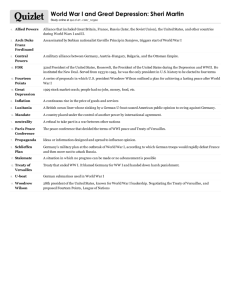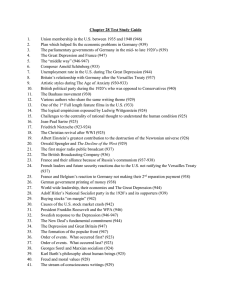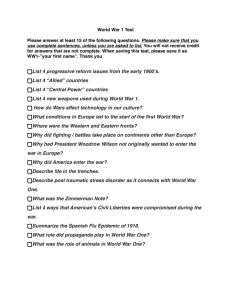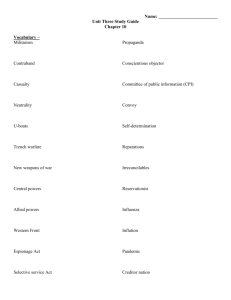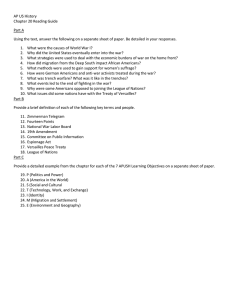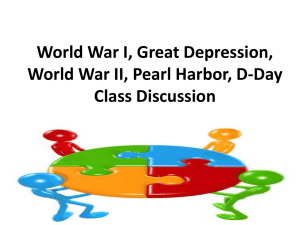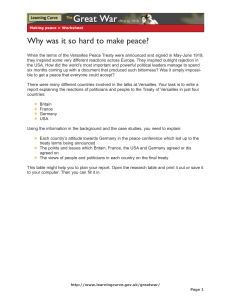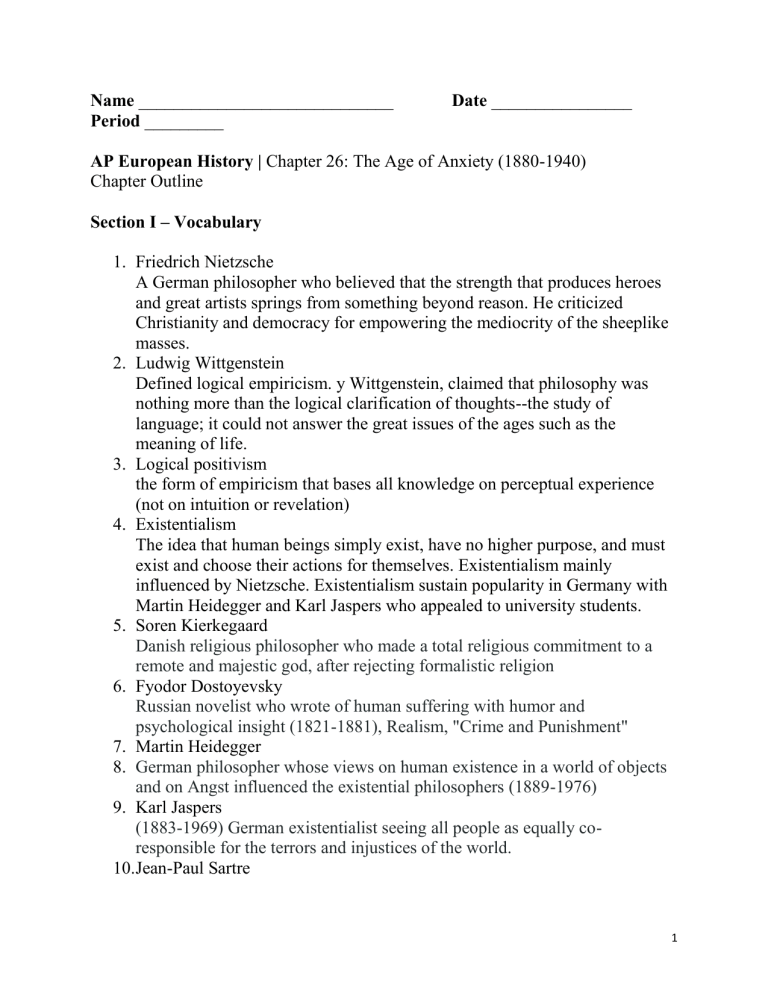
Name _____________________________ Period _________ Date ________________ AP European History | Chapter 26: The Age of Anxiety (1880-1940) Chapter Outline Section I – Vocabulary 1. Friedrich Nietzsche A German philosopher who believed that the strength that produces heroes and great artists springs from something beyond reason. He criticized Christianity and democracy for empowering the mediocrity of the sheeplike masses. 2. Ludwig Wittgenstein Defined logical empiricism. y Wittgenstein, claimed that philosophy was nothing more than the logical clarification of thoughts--the study of language; it could not answer the great issues of the ages such as the meaning of life. 3. Logical positivism the form of empiricism that bases all knowledge on perceptual experience (not on intuition or revelation) 4. Existentialism The idea that human beings simply exist, have no higher purpose, and must exist and choose their actions for themselves. Existentialism mainly influenced by Nietzsche. Existentialism sustain popularity in Germany with Martin Heidegger and Karl Jaspers who appealed to university students. 5. Soren Kierkegaard Danish religious philosopher who made a total religious commitment to a remote and majestic god, after rejecting formalistic religion 6. Fyodor Dostoyevsky Russian novelist who wrote of human suffering with humor and psychological insight (1821-1881), Realism, "Crime and Punishment" 7. Martin Heidegger 8. German philosopher whose views on human existence in a world of objects and on Angst influenced the existential philosophers (1889-1976) 9. Karl Jaspers (1883-1969) German existentialist seeing all people as equally coresponsible for the terrors and injustices of the world. 10.Jean-Paul Sartre 1 A French existentialist who said that people just "turned up" and that there was no God to help honest people. Also said "man is condemned to be free" and people had to choose their actions. 11.Simone de Beauvoir French author of The Second Sex. She argued for women's rights and was also a prominent figure in the existentialist movement. She died in 1986. 12.Albert Camus (1913-1960) was the leading French existentialist; he became extremely influential, and joined the French resistance. Him and Sartre offered powerful answers to moral issues and the contemporary crisis. 13.Gabriel Marcel Found in the Catholic church an answer to what he called the postwar "broken world." Religious belief proveded hope, humanity, honesty, and piety for which he hungered. 14.T.S. Eliot (1888-1965), portrayed a world of growing desolation but eventually hoped cautiously for humanity's salvation 15.Theory of special relativity Albert Einstein's theory that time and space are relative to the observer and that only the speed of light remains Constant. 16.Sigmund Freud The Viennese founder of psychoanalysis who believed that mental problems originated in the past. Fascinated with tensions resulting from the son's instinctive competition with his father for the mother's love. Much of unconscious psychological energy is sexual energy. 17.Gustav Mahler Composer, Jewish, hard life which was reflected in his music, late-Romantic style 18.Gustav Klimt viennese painter who painted "the kiss," which exemplified the way secessionists created abstract works rooted in depths of emotion 19.Id, ego, and superego freudian terms to describe the three parts of the self and the basis of human behavior id: unconscious (pleasure) ego: balanced id and superego superego: overly strict and puritan 20.Modernism 2 A cultural movement embracing human empowerment and rejecting traditionalism as outdated. Rationality, industry, and technology were cornerstones of progress and human achievement. 21.Functionalism the principle that buildings, like industrial products, should serve as well as possible the purpose for which they were made. 22.Bauhaus a German interdisciplinary school of fine and applied arts that brought together many leading modern architects, designers, and theatrical innovators 23.Claude Monet a French painter who used a impressionism called "super-realism," capture overall impression of the thing they were painting 24.Edgar Degas French realist/impressionist painter who painted about the movement of the human body 25.Mary Cassat American Artist who used impression and became famous with The Letter. 26.Impressionism Went against realism. Focused on the ability to capture a single moment. Borrowed from Asian tech-niques which also come from imperialism from 19th century 27.Futurist An Italian school of painting [1909-19] that conveys the dynamism of the twentieth century, the machine age, and the glories of war. It heralded the emergence of fascism. 28.Dadaism A nihilist movement (1916-22) originated in Europe by the French poet Tristan Tzara and continued in the United States by Duchamp, Arp, and Ernst. Dadism laid foundation for Surrealism. 29.Vincent van Gogh dutch post impressionist artist. painted "the starry night" 1889. mentally ill in later life. cut off his own ear. influential in the world of painting, very famous 30.Filippo Tommaso Marinetti founded futurism ; argued traditional culture could not deal w/ the advancements in technology 31.Salvador Dali "The Persistence of Memory"-normal objects distorted-irrational was tangible 3 32.Surrealism wanted a reality beyond the material/sensible world/ found it in the world of the unconscious- fantasies/dreams/nightmares 33.Marcel Proust 20th century French author; wrote semi-autobiographical Remembrance of things Past, which recalls bittersweet memories of childhood and youthful love and tries to discover their innermost meaning; lived like a hermit in a soundproof apartment for ten years, withdrawing form the present to live in the past. 34.Stream-of-consciousness technique the narrative technique that attempts to reproduce the full and uninterrupted flow of a characters mental process, in which ideas, memories, and sense impressions may intermingle without logical transitions 35.“modern girl” a figure around 1925 who gained popularity because she embodied the exhilaration of Japanese modern times; she was a stylish follower of fashion; she could enjoy economic independence, sexual freedom and political freedom. Celebrated and feared for her new sexuality; she was also a global phenomenon 36.Mass consumerism The working class can buy the things they're making. 37.Sergei Eisenstein Film director who had a creative imagination using new techniques for editing films, portraying dramatic action, and representing political themes. Produced Potemkin a movie about the Russian Revolution of 1905 38.Leni Riefenstahl’s Triumph of the Will Hitler used this filmmaker to make documentary propaganda. Her film, Triumph of the Will, depicts the joyful crowds and mass procession of Nazi followers welcoming Hitler at Nuremberg in 1934. This is significant because this new media was becoming a potentially dangerous instrument of political manipulation. 39.John Maynard Keynes’ The Economic Consequences of the Peace (1919) Keynes denounced the Treaty of Versailles in his book Economic Consequences of the Peace. This English economist aid that the Treaty would impoverish Germany and encourage Bolshevism. He also encouraged governments to spend during the Great Depression in order to get the economy going again. This is significant because FDR supported it. 40.Gustav Stresemann He assumed leadership of Germany in August 1923 as the foreign minister. He opted an attitude of compromise and tried to negotiate a re-examination 4 of Germany's ability to pay the reparations. The first of these examinations was the Dawes Plan. 41.Dawes Plan War reparations agreement that reduced Germany's yearly payments, made payment dependent on economic prosperity, and granted large US loans to promote recovery. This was significant because it caused a debt exchange and therefore the economies of the world's superpowers became intertwined. When one country crashed, as it did in 1929, they all crashed as a result. 42.Great Depression A worldwide economic depression from 1929 through 1939, unique in its severity and duration and with slow and uneven recovery. 43.Franklin Roosevelt’s “New Deal” The goal of the New Deal was to preserve capitalism through reform. FDR introduced social legislation including social security and attacked the problem of mass unemployment by using federal government funds to support public works projects. 44.Popular Front A short-lived New Deal-inspired alliance between Communists, Socialists, and Radicals in France led by Léon Blum that encouraged the union movement and launched a far-reaching program of social reform. 45.Leon Blum Leon Blum, who began as a literary critic, became active in politics as a result of the Dreyfuss Affair. In 1919, he was elected to the French Chamber of Deputies. In 1925, he became the head of the Socialist Party and, in May 1936, he became France's first socialist Prime Minister since 1870. During his one year in office, he instituted a number of important social reforms, including the 40-hour work week. He used the Popular Front very successfully and it was used the workers and lower middle class. Revolutions by conservatives and inflation ruined the Popular Front and because of this Blum was forced to resign in June 1937. Section II – Focus Questions 1. How did intellectual developments reflect the general crisis in Western thought? (864) The decades surrounding the First World War — from the 1880s to the 1930s — brought intense cultural and intellectual experimentation. As people grappled with the costs of the First World War and the di culty of postwar recovery, philosophers and scientists questioned and even abandoned many of the cherished values and 5 beliefs that had guided Western society since the eighteenth-century Enlightenment and the nineteenth- century triumph of industry and science. ough some intellectuals turned to Christianity, others rejected Christian teachings and dismissed the possibility that rational thought could lead to greater human understanding or social progress. Radical intellectual thought thus dovetailed with the ongoing political and social crisis, and many people felt anxious and adrift in a world without certainties. Historians nd it relatively easy to set precise dates for political events, such as the outbreak of wars or the outcome of national elections. Exact dates for the rise and fall of intellectual and cultural developments are much more di cult to de ne. e emergence of mod- ern philosophy, for example, did not follow the clear- cut timelines of political history. us to understand the history of modern thought, we must investigate trends dating back to the last decades of the nine- teenth century and follow them into the 1950s. 2. How did modernism revolutionize Western culture? (877) Fundamental innovations in the basic provision and consumption of goods and services accompanied the radical transformation of artistic and intellectual life. After the First World War, modern business forms of credit, retail, and advertising helped sell increasing numbers of mass-produced goods — the products of a highly industrialized factory system—to ever-larger numbers of people. With the arrival of cinema and radio, commercial entertainment increasingly dominated the leisure time of ordinary people. e consumer revolution had roots in the prosperous decades before World War I and would not be fully consolidated until the 1950s and 1960s. Yet in the interwar years the out- lines of a modern consumer society emerged with star- tling clarity. 3. How is modernism different than previous artistic movements such as romanticism and realism? 6 Modernism was diff rent than previous artistic movements such as romanticism and realism. It was a label given to the artistic and cultural movements of the late nineteenth and early twentieth centuries, which were typied by radical experimentation that challenged traditional forms of artistic expression. People of not just high class were viewing art and creating it, pushing through the normal styles of rococo or baroque and creating new ideas. 4. What obstacles to lasting peace did European leaders face? (880) As established patterns of thought and culture were further challenged and mangled by the ferocious im- pact of World War I, so too was the political fabric stretched and torn. e Versailles settlement had estab- lished a shaky truce, not a solid peace. After the war, leaders faced a gigantic task as they sought to create a stable international order within the general context of intellectual crisis, slow economic growth, and political turmoil. e pursuit of real and lasting peace proved di cult for many reasons. Germany hated the Treaty of Ver- sailles. France was fearful and isolated. Britain was undependable, and the United States turned its back on European problems. Eastern Europe was in ferment, and Communist Russia had an unpredictable future. Moreover, the international economic situation was weak and greatly complicated by war debts and dis- rupted patterns of trade. Yet from 1925 to late 1929, it appeared that peace and stability were within reach. When the economic collapse of the 1930s mocked these hopes and brought the rise of brutal dictators, the disillusionment of liberals in the democracies in- tensi ed. 5. What were the causes and consequences of the Great Depression? (885) Beginning in 1929, a massive economic downturn struck the entire world with ever-greater intensity. Recovery was slow and uneven, and contemporaries labeled the eco- nomic crisis the Great Depression, to emphasize its severity and duration. Only with the Second World War did the depression disappear in much of the world. e social and political consequences of the Great Depression were 7 enormous. Mass unemployment and failing farms made insecurity and unemployment a re- ality for millions of people (Map 26.1). In Europe and the United States, governments instituted a variety of social welfare programs intended to manage the crisis. Yet the prolonged economic collapse shattered the frag- ile political stability of the mid-1920s and encouraged the growth of extremists on both ends of the political spectrum. Democratic government faltered, and authoritarian Fascist parties gained power across Europe. 6. How did trends in politics, economics, culture, and the arts and sciences come together to create a general sense of crisis in the 1920s and 1930s? Before 1914 most people still believed in Enlighten- ment ideals of progress, reason, and individual rights. At the turn of the century supporters of these philosophies had some cause for optimism. Women and work- ers were gradually gaining support in their struggles for political and social recognition, and the rising standard of living, the taming of the city, and the growth of state-supported social programs suggested that life was indeed improving. Such developments encouraged faith in the ability of a rational human mind to discover the laws of society and then wisely act on them. Nevertheless, in the late nineteenth century a small group of serious thinkers mounted a determined at- tack on these optimistic beliefs. ese critics rejected the general faith in progress and the rational human mind. e German philosopher Friedrich Nietzsche (1844–1900) was particularly in uential, though not until after his death. Never a systematic philosopher, he wrote more as a prophet in a provoca- tive and poetic style. In the rst of his Untimely Medita­ tions (1873), he argued that ever since classical Athens, the West had overemphasized rationality and sti ed the authentic passions and animal instincts that drive human activity and true creativity. With new radical ideas coming out, countries left in ruin from world war, and people with no where else to turn either panicked or gave way into these new schools of thoufh creating a sense of crisis in the 1920's and 1930's. 8 7. To what extent did the problems of the 1920s and 1930s have roots in the First World War? (Ch. 25) Germany was the key to lasting stability. Yet to Ger- mans of all political parties, the Treaty of Versailles represented a harsh dictated peace, to be revised or repudiated as soon as possible. Germany still had the potential to become the strongest country in Europe but remained a source of uncertainty. Moreover, with ominous implications, France and Great Britain did not see eye to eye on Germany. Immediately after the war, the French wanted to stress the harsh elements in the Treaty of Versailles. Most of the war in the west had been fought on French soil, and the expected costs of reconstruction, as well as of repaying war debts to the United States, were staggering. us French politicians believed that mas- sive reparations from Germany were vital for economic recovery. After having compromised with President Wilson only to be betrayed by America’s failure to rat- ify the treaty, many French leaders saw strict imple- mentation of all provisions of the Treaty of Versailles as France’s last best hope. Large reparation payments could hold Germany down inde nitely, ensuring French security. As a result of this, the Germans grew worse and worse into a war machine when the nazi party took over. I believe that to a very large extent that the problems of the 20's and 30's have roots in the First World War. 8. What made modern art and intellectual thought “modern”? Modern art was considered modern because it was the first time art appealed to all audiences and was available to everyone. The appreciation of its simplicity led the rich to enjoy it and the poor to enjoy it without being ridiculed. Typically, a musical background would be required to appreciate classical music, a low class individual may think it sounds good but the aristocracy ridicules them for not analyzing the complexity. Bach, for example, made pieces that everyone could 9 enjoy and even held concerts not for the upper class. Essentially the modern part in modern art allowed for all people to enjoy it, and in doing so it pushed the normally boundaries of art. 10
